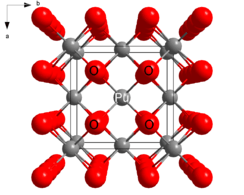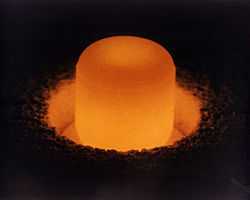Plutonium(IV) oxide
 | |
| Names | |
|---|---|
| IUPAC name
Plutonium(IV) oxide | |
| Systematic IUPAC name
Plutonium(4+) oxide | |
| Other names
Plutonium dioxide | |
| Identifiers | |
| 12059-95-9 | |
| ChemSpider | 10617028 |
| |
| Jmol-3D images | Image |
| |
| Properties | |
| Molecular formula |
O2Pu |
| Molar mass | 276.06 g·mol−1 |
| Appearance | Dark yellow crystals |
| Density | 11.5 g cm−3 |
| Melting point | 2,400 °C (4,350 °F; 2,670 K) |
| Boiling point | 2,800 °C (5,070 °F; 3,070 K) |
| Structure | |
| Crystal structure | Fluorite (cubic), cF12 |
| Space group | Fm3m, No. 225 |
| Tetrahedral (O2−); cubic (PuIV) | |
| Hazards | |
| Main hazards | Radioactive |
| Except where noted otherwise, data is given for materials in their standard state (at 25 °C (77 °F), 100 kPa) | |
| | |
| Infobox references | |
Plutonium(IV) oxide is the chemical compound with the formula PuO2. This high melting-point solid is a principal compound of plutonium. It can vary in color from yellow to olive green, depending on the particle size, temperature and method of production.[1]
Structure
PuO2 crystallizes in the fluorite motif, with the Pu4+ centers organized in a face-centered cubic array and oxide ions occupying tetrahedral holes.[2] PuO2 owes its utility as a nuclear fuel to the fact that vacancies in the octahedral holes allows room for fissile products. In nuclear fission, one atom of plutonium splits into two. The vacancy of the octahedral holes provides room for the new product and allows the PuO2 monolith to retain its structural integrity.
Properties
Plutonium dioxide is a stable ceramic material with an extremely low solubility in water and with a high melting point (2,390°C).[3]
Due to the radioactive alpha decay of plutonium, PuO2 is warm to the touch. As with all plutonium compounds, it is subject to control under the Nuclear Non-Proliferation Treaty.
Synthesis
Plutonium metal spontaneously oxidizes to PuO2 in an atmosphere of oxygen. Plutonium dioxide is mainly produced by calcination of plutonium(IV) oxalate, Pu(C2O4)2·6H2O, at 300 °C. Plutonium oxalate is obtained during the reprocessing of nuclear fuel. Plutonium dioxide can also be recovered from molten-salt breeder reactors by adding sodium carbonate to the fuel salt after any remaining uranium is removed from the salt as its hexafluoride.
Applications

PuO2, along with UO2, is used in MOX fuels for nuclear reactors. Plutonium-238 dioxide is used as fuel for several deep-space spacecraft such as the 'New Horizons' Pluto probe as well as in the Curiosity rover on Mars. The isotope decays by emitting α-particles which then generate heat (see radioisotope thermoelectric generator). There have been concerns that an accidental orbital earth re-entry might lead to the break-up and/or burn-up of a spacecraft, resulting in the dispersal of the plutonium, either over a large tract of the planetary surface or within the upper atmosphere.
Physicist Peter Zimmerman, following up a suggestion by Ted Taylor, demonstrated that a low-yield (1-kiloton) nuclear weapon could be made relatively easily from plutonium oxide.[4]
Toxicology
The behavior of plutonium oxide in the body varies with the way in which it is taken. Since it is insoluble, when ingested, a very large percentage of it will be eliminated from the body quite rapidly in body wastes.[5] In particulate form, plutonium oxide at a particle size less than 10 micrometers (0.01 mm)[3] is toxic if inhaled, due to its alpha-emission.[6]
See also
References
- ↑ "Nitric acid processing". Los Alamos Laboratory.
- ↑ Greenwood, Norman N.; Earnshaw, Alan (1984). Chemistry of the Elements. Oxford: Pergamon Press. p. 1471. ISBN 0-08-022057-6.
- ↑ 3.0 3.1 World Nuclear Society, Plutonium (accessed Nov 29 2013)
- ↑ Michael Singer, David Weir, and Barbara Newman Canfield (Nov 26, 1979). "Nuclear Nightmare: America's Worst Fear Come True". New York Magazine.
- ↑ United States Nuclear Regulatory Commission, Fact sheet on plutonium (accessed Nov 29 2013)
- ↑ "Toxicological Profile For Plutonium" (PDF). U.S. Department of Health and Human Services. 2007-09-27. Retrieved 2009-04-23.
External links
| ||||||||||||||||||